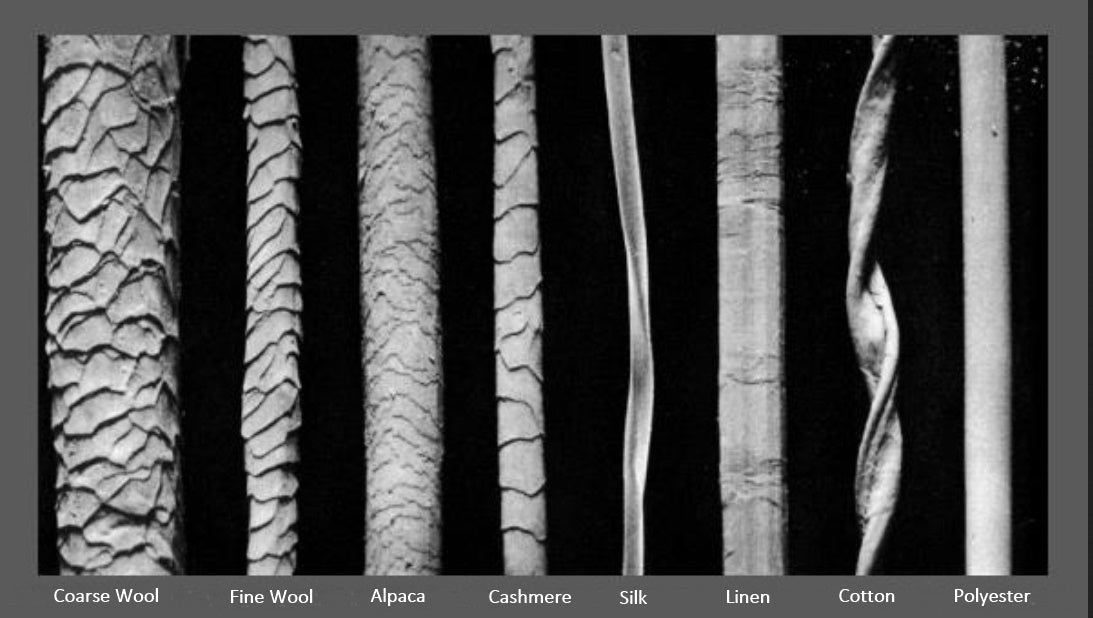- Regular Price
- £19.99
- Sale Price
- £19.99
- Regular Price
- £19.99
- Unit Price
- per


For over 12,000 years, wool has been harvested by humans in the spring or summer from these animals to create warm, protective clothing and textiles for a multitude of uses, allowing them to regrow the fleece for the autumn and winter. Harvesting is done by shearing, brushing, or collecting from bushes or plants that the animal has rubbed against, naturally moulting the fleece for warmer weather.
Wool is a natural protein-based fibre that belongs to the category of animal fibres. It is primarily composed of keratin, which is a fibrous protein that serves as a fundamental building block for various biological structures, including hair, nails, horns, and feathers. Keratin is abundant in nature and is known for its toughness, strength, and flexibility. Our hair and nails are made of this.
Wool differs from fur and hair, as it is crimped, is elastic and contains high levels of naturally occurring oils called lanolin. This natural waviness along the length of the fibre is a result of the helical arrangement as this grows out of the animal's hair follicles and grows in staples (clumps). This crimp creates natural curls or waves in the wool, which contribute to its elasticity and resilience allowing it to return to its original shape even after being stretched or compressed. It makes wool a fabulous fibre for garments and textiles, as it ensures they retain their shape and lasts longer.
Wools' crimp also creates air pockets, enhancing its insulating properties and making it effective at regulating temperature and moisture.

Angora Goats

Muskox
The Muskox has a 'double coat' of long guard hairs over a soft, light, extremely fine undercoat for insulation that protect them from extreme co

Merino Sheep: Before shearing, the farmer prizes the wool apart to show the fineness of the wool and crimp.
The Merino sheep is famed for its fabulous fleece - the longest and most crimped fleece of all.

Merino Sheep with its full coat ready to be shorn
The structure of wool fibres is a complex arrangement of different components. At a molecular level, keratin is made up of long chains of amino acids, which are the basic building blocks of proteins. These chains are rich in sulfur-containing amino acids, such as cysteine, which contribute to the strong and resilient nature of keratin.
Wool fibres have a distinctive microscopic structure that gives them their unique properties. The fibres are covered with tiny scales, somewhat resembling the structure of fish scales. These scales are essential for felting. Felting is the process where wool fibres interlock and mat together under the influence of moisture, heat, and agitation. This characteristic makes wool an ideal material for applications like felting crafts. But, it also has its downsides, as we all know when our favourite wool creation has been foolishly washed on a non-wool wash cycle and your wool socks would just about squeeze over your dogs' paws and your jumper would be perfect (albeit bulky) for a newborn baby.

Electron microscope image of cashmere fibres
Although the scales can be seen, they lie very flat against the shaft, that gives cashmere the famed softness and non-irritability against the skin.
As a renewable and biodegradable resource, wool has a remarkable combination of natural properties for insulation, moisture-wicking, flame resistance, and durability. Its why we are big fans for this incredible fibre...
6 comments
Really interesting article- thanks!
Most interesting reading, very informative giving food for thought especially as Winter is just around the corner and it will soon be time to think of special Christmas presents.
Please send any details of presents by email for me to consider.
Thank you
Wool is my favourite fabric for cold weather but I’m a real sucker for the shine and luxury of silk.
Apparently silk doesn’t last and becomes very thin and delicate over time. Is this true of wool too?
Thank you for the fascinating information about ‘wool’ – I really enjoyed reading it.
Very interesting. I think I heard or read (during Covid) that wool also has properties that mean it’s good when there are viruses or any germs as it doesn’t release any virus that it may pick up until it’s washed. is that right? Maybe I’ve explained it wrongly!
This is a very interesting read… thank you!